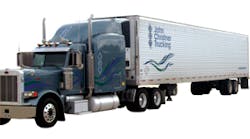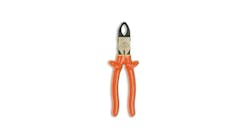With the rising cost of doing business nowadays, effective vehicle maintenance and repair takes on even greater significance. More and more fleets and service providers are working to improve their efficiency in getting vehicles serviced and gain the greatest return on investments in tools and equipment.
But that is not the case at John Chirstner Trucking in Sapulpa, OK, a family-run truckload fleet that specializes in transporting temperature controlled products - from -20 to +90 degrees Fahrenheit. Creating and continuing best maintenance practices has been the guiding principle since day one. When John Christner founded the company in 1986, he built a shop before an office.
His business philosophy can be encapsulated thusly: be proactive in keeping the fleet on-the-road operating efficiently, and constantly be looking for tools, methods and technology that can be used to improve things. And that philosophy has paid off. John Christner Trucking is one of the top temperature controlled truckload companies in North America. It has an industry-wide, well-deserved reputation for having a superbly maintained fleet.
The company operates about 750 tractors - an assortment of Kenworth, Peterbilt, Freightliner and International models. It was an all Caterpillar engine fleet, but with the engine manufacturer no longer building truck engines, John Christner Trucking is now using Cummins and Detroit Diesel engines, from 450 to 470 horsepower. These are mated to 10-speed Eaton Fuller transmissions.
Tractors are ordered with upgraded owner operator specs and components, along with equipment and accessories specific to the fleet's operation and application requirements operation. The power units also come with extended warranties.
Tractors generally average about 140,000 miles per year, with the typical length of haul being 1,100 to 1,200 miles. Tractors are commonly traded after about three years.
The truck specs and mileage help enhance resale value, says Steve Dickson, vice president of maintenance. Plus, it helps keep maintenance and repairs to regular PM work and minor repairs.
"We can literally do anything here," he says. "We can rebuild engines and we have our own body shop and paint booth. But we prefer not to. Most of our major issues and problems are generally handled under vehicle warranty."
The fleet's shop, which operates around the clock, is staffed with 37 truck technicians "who have certifications across the board." It also has a truck wash on the premises, but contracts out the labor.
John Christner Trucking's 970 trailers are all 53-foot, air-ride suspension Great Dane and Utility models, the majority of which have Thermo King refrigeration units. The remainder have Carrier Transicold units. The reefers usually run around 3,000 hours per year. Trailers are on a five-year trade cycle.
Last year the fleet repowered the refrigeration units on some 200 of its trailers to extend their useful life. "We couldn't get good trade numbers so we elected to repower and run them another three to four years," Dickson says.
IMPROVEMENT STRATEGY
The fleet is constantly looking for better ways of maintaining its vehicles and is regularly trying out new products and different ways of doing things. By way of example, Dickson cites the use of ESOC Commercial Trucks' engine oil exchange machines. The units are environmentally safe oil evacuation systems that reduce labor time and costs and help minimize truck downtime.
About three and a half year ago, Dickson first saw an ESOC engine oil change exchange system at a truck quick lube facility. Shortly thereafter he then noticed a couple of his trucks come in with the two special ESOC drain fittings. He began looking into the quick oil change technology system and decided: "It made perfect sense," he recalls.
"With the ESOC system, technicians don't have to worry about removing the drain plug, positioning the bucket correctly to catch all the oil that drains out and doing all the processes associated with changing engine oil," says Dickson. "The technician simply attaches the two lines to the fittings, programs the ESOC machine, starts it and let then lets it do its thing."
Initially, two low-profile, quick-connect, spill-free fittings are attached to the engine and left in place. The fittings are designed so that it is impossible to have a wrong connection.
The ESOC system's closed-loop technology automatically sends clean, dry air to purge the inlet side of the filter, forcing the used oil out of the filter and out of the lubricating passages down into the oil pan. Simultaneously, the used oil is being evacuated from the oil pan into a holding tank, and an oil sample can be automatically drawn.
After the purged air stops, the oil exchanger signals with an audible and on-screen alert that the engine is now clean of waste oil. At this point, the used oil filter can be replaced with a new one - even while the oil is still being evacuated. Because the used filter has been purged, it can be removed without spilling oil.
After the used oil is removed from the oil pan, the pump stops automatically. By following the on-screen instructions, a pre-selected amount of fresh oil is introduced through the inlet side of the oil filter pre-filling the oil filter and lubricating oil passages and the crankcase. At the start-up, the oil filter is full and the oil passages inside the engine are pre-lubricated so that upon engine start-up, there is instant oil pressure.
At John Christner Trucking, the captured waste oil is used to heat the fleet's drive-through bay shop.
The fleet bought the ESOC Series 1000 oil changer and positioned the stationary unit in between two of its drive-through shop bays. This allows technicians to do more oil changes without having to move trucks in and out as much, further increasing technician and shop productivity.
"The technicians really appreciate the system," Dickson notes. "It requires no special training and cuts down on the time and effort needed to change oil. There is a lot less mess so they're working in a cleaner environment."
The ESOC Series 1000 "is a very handy piece of equipment," remarks technician Bruce Kuka, who has been with John Christner Trucking for 10 years. "You don't have to pull drain plugs or drop oil pans, and that helps keep us and the shop cleaner. It also helps us get oil changes done faster."
"The system is simple to operate because of the easy-to-follow on-screen instructions," Brian Mattson, another 10-year technician at the fleet, says. "You program in the truck number, mileage, whether or not you want an oil sample, how much oil to put it and then you start the operation."
"It does everything automatically, even draining the oil filter and pre-priming it so there are no dry starts," adds Kuka. "Because the process is automatic, we can go off and do something else, so we get more things done in less time," says Mattson.
The ESOC engine oil change system worked so well, John Christner Trucking bought another system, the Series 850. It is portable unit that is used to change the oil in the engines on the trailer refrigeration units. This machine operates in the same fashion as the ESOC 1000.
With both the Series 850 and Series 1000 systems, oil changes can be completed in about 10 minutes, saving on average 20 minutes when compared to using the conventional gravity drain method.
Management control is another benefit of the ESOC oil change systems, points out Dickson. The systems include tracking oil totals by day, week, month and year. There is also the ability to download oil change history to a computer spreadsheet and store individual vehicle data in a database.
FIELD TESTING
The fleet regularly tries out new products and different ways of doing things. That is how the fleet has come to use wide-base tires - a single tire and wheel used in place of two standard tires and wheels.
After recently completing testing with wide-base tires, the fleet has specified them on an order for 100 new trailers.
"We found that wide-base tires provide some weight and maintenance savings over dual assemblies and offer a better ride," says Dickson. "However, we have some concern about the infrastructure and being able to get a replacement tire if one goes now in a small town off the beaten track. We have temperature- and time-sensitive loads and we can't have trucks down for long periods of time."
INFORMATION TRACKING
The fleet has always been big on tracking maintenance and repair costs, ever vigilant for issues and trends, Dickson says. It incorporates technology to help do this.
Among the technologies its uses to help manage fleet logistics is Qualcomm satellite mobile communications and information management systems. Qualcomm units are installed in each tractor.
To improve reefer maintenance, the fleet is using Qualcomm's refrigeration unit monitoring service. This allows remote monitoring of load temperatures and unit status.
The fleet also uses various technology systems to monitor and track onboard vehicle operation and collects this information through engine downloads.
All this data is analyzed and used to more efficiently run the fleet's maintenance operations, explains Dickson. By regularly collecting this data and benchmarking, the maintenance operation can measure its performance, see where improvement is needed and identify any maintenance or service issues, trends or problems.
Several years ago, he discovered that the fleet was having wheel end issues on its trailers. High wheel end temperatures were creating the need for repairs, which caused added vehicle downtime and maintenance costs.
In looking for solutions, Dickson settled upon the Meritor Tire Inflation System (MTIS) by PSI with ThermAlert. An option, the ThermAlert is a wheel-end heat-sensing capability that acts as an early warning system to help reduce potential risks, costs and downtime associated with wheel loss, and wheel and tire fires and failures.
The system not only solved the wheel end issues, Dickson notes, but had the added benefit of increasing tire life and reducing tire maintenance costs.
MTIS is an active, fully automatic inflation system that monitors and maintains tire air pressure. It uses compressed air from the trailer's air system to inflate any tire that falls below a preset pressure whenever the vehicle is in operation. As air pressure drops below the tire manufacturer's recommended level, MTIS automatically routes air through a control box, then into each axle. The axles carry the air to a rotary union at the spindle that distributes the correct amount of air to each tire as needed.
The ThermAlert system detects when air is escaping from the axle's thermal plug and out through the hubcap tee vent. This occurs if a wheel end is operating at an abnormally high temperature. If the temperature of the wheel-end exceeds the melting point of the eutectic material, the thermal screw will melt causing pressurized air to vent through the hub cap tee vent.
When this situation happens, the MTIS indicator light will come on to alert the driver to a problem. Air escaping from the tee vent produces an audible noise, which helps to identify the wheel end that is overheated.
MTIS with ThermAlert has been retrofitted to about 500 John Christner Trucking trailers and is now being spec'd on all new trailers.
ENERGY EFFICIENCY
Another way the fleet is working to reduce operational expenses is by outfitting its tractors with auxiliary power units (APU). About 70 percent of the tractors have APUs. This component has been added, Dickson says, to lower fuel costs by reducing idling. This conserves fuel and helps reduce engine wear and tear, which in turn can help extend tractor engine service intervals.
The majority of the APUs are Thermo King TriPacs systems.
John Christner Trucking initially started looking at APUs in 2004 when the fleet participated in a study on using battery-powered HVAC units on trucks. The study was conducted by the Sacramento, CA, Municipal District. The fleet had a dedicated operation there.
"We had six trucks with the units," recalls Dickson, "and we got the best performance of all the fleets involved in the study."
John Christner Trucking became a SmartWay Transport Partner in 2004. Becoming a Transport Partner means a carrier agrees to assess its operations and take actions to improve its fleet fuel efficiency. The fleet won a SmartWay Excellence Award three years later.
MAINTENANCE ISSUES
While John Christner Trucking faces the same maintenance challenges as all other temperature-controlled trucking operations, it has some unique ones. "We're an all lease operator fleet and this presents a whole different set of problems than the average driver fleet," says Dickson.
The company buys the tractors and leases them to the operator with the intention that they will buy them. All trailers are company owned.
"One of our main challenges is making sure the lease operators adhere to our PM schedules. We've developed these over time specifically for our operation."
As part of the business arrangement with John Christner Trucking, lease contractors agree to abide by the company's PM schedule. They aren't required to use the company's shop for repairs and maintenance services, however. Lease contractors may use any shop approved by the fleet.
"All trucks must go through our company shop every 90 days for a no-charge inspection, primarily to make certain the equipment would pass a U.S. DOT roadside inspection," Dickson explains. "This helps us make sure our operators are complying with our PM programs.
"It just one of the many things we do to support them and help them be successful and profitable. Their success determines our success."
For repairs and problems on the road, operators contact John Christner Trucking's Road Assist group to direct them to authorized service providers and then follow up on the repairs.
The fleet operates its own wrecker which operates nationwide. "It has gotten more use over the past year or so as service providers have shown their true colors with ridiculously excessive estimates on repairs," says Dickson. "They don't care about the trucker, just their bottom line."
DEVELOPMENT PROCESS
Dickson says retaining technicians hasn't been a problem. However, recruiting technicians gets a little more difficult every year. When looking for a technician, the fleet seeks specific qualifications and experience that will help determine a good fit.
The fleet's technicians have numerous certifications and training is continual. For technicians who come on board, especially those with little experience, there is a mentoring program to help them develop.
The fleet works with votech schools as a way to find technicians, but Dickson stresses: "These schools need to get real about their education. My big issue with them is that they teach the fundamentals of diesel mechanics but nothing on U.S. DOT regulations relating to truck maintenance.
"They will teach a student how to work on an old Cummins PT pump that we haven't seen in years, but not what brake travel is and what it should be."
BASIC FACTORS
Dickson attributes the continuing success of the maintenance operation at John Christner Trucking to a number of key elements. Chief among these: thoroughly assessing and re-examining the fleet's needs and related maintenance practices; looking for and evaluating products, services and process that can improve both vehicle and shop efficiencies and productivity while lowering costs; having good information and data upon which to base decisions; and striving for continuous improvement.
Along with that, Dickson says, "we have good people in the right positions." No easy task for the maintenance department of 73 people that he oversees.
"My part on the team is to throw out ideas and be instrumental in helping others see a better way of doing something. I'm always encouraging suggestions and recommendations.
"I'm bigger on leadership than management," he goes on. "I subscribe to what General Patton said: 'Never tell people how to do things. Tell them what to do and they will surprise you with their ingenuity.'"
All of these factors work together to achieve ever-increasing levels of operational performance, concludes Dickson. "That leads to elevated driver and customer satisfaction, and that leads to continued company growth and profitability.




